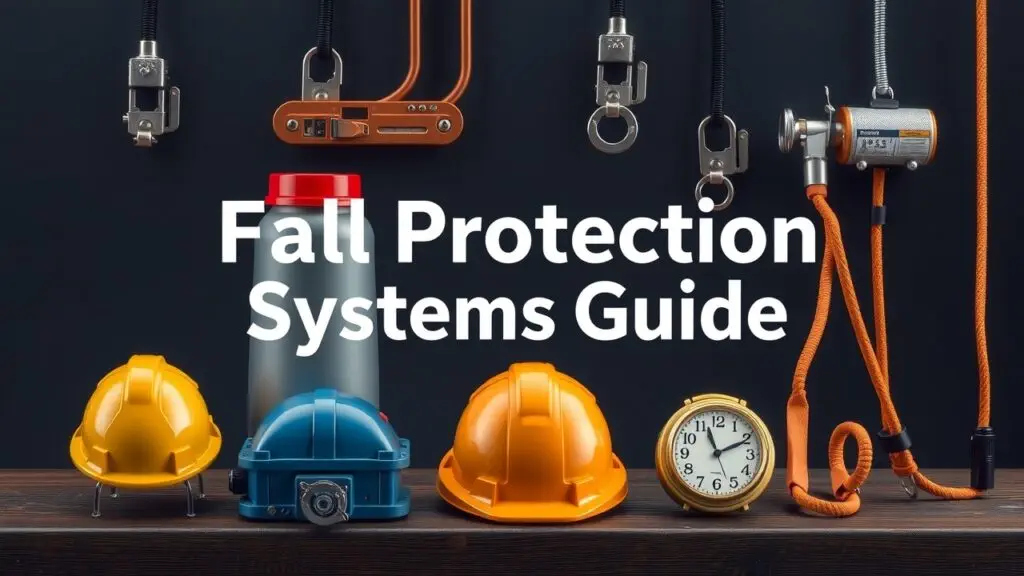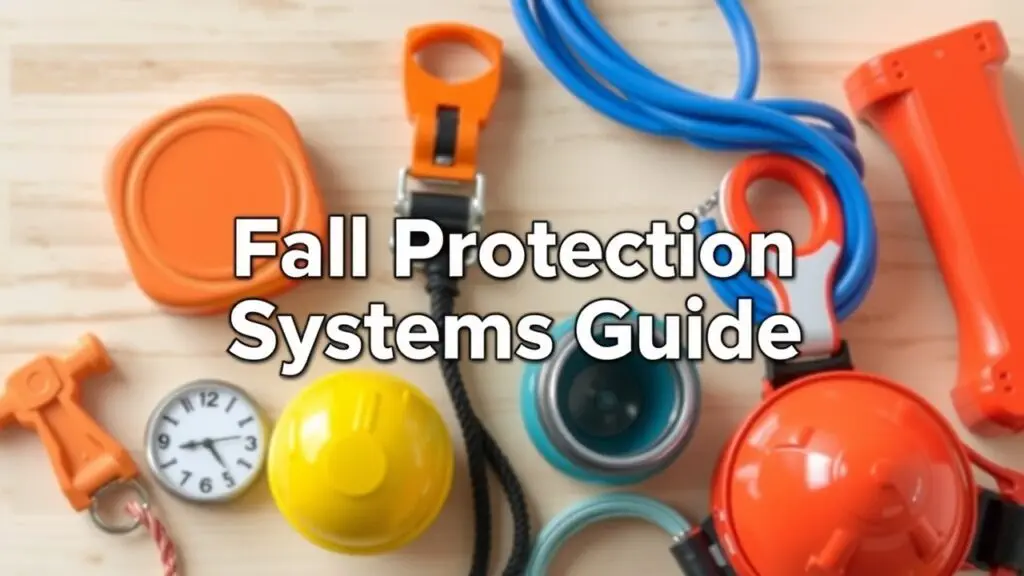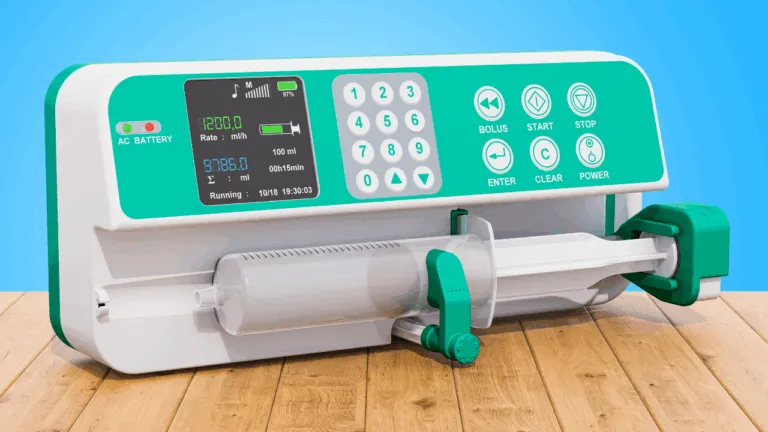Types of fall protection are crucial for workplace safety. This guide covers fall arrest, restraint, and prevention systems, including system selection.
What Are Fall Protection Systems?

Fall protection systems are safety measures that keep workers from falling when they work at heights. They also help protect them if a fall happens. These systems include various equipment and methods like personal protective equipment (PPE) and safety railings. The main goal is to reduce the risk of injuries or fatalities due to falls in different work settings.
In fields like construction, telecommunications, and industrial jobs, these systems play a vital role. Workers often have to perform tasks high above the ground, which increases the chances of falling. Having good fall protection not only meets safety rules but also promotes a safer workplace for everyone.
Why Understanding Different Types Matters?
Choosing the right fall protection system depends on the work environment and tasks at hand. For example, working on rooftops may need different types of harnesses than scaffolding because the risks can be different. A good hazard assessment helps figure out what type of system will keep workers safest based on where they are working.
There are also legal requirements under OSHA regulations that stress the importance of this knowledge. Employers must look for fall hazards in their workplaces and put appropriate fall protection systems in place. This includes following guidelines about personal fall arrest systems (PFAS) and making sure all employees get proper training to use this equipment correctly.
By understanding how different types of fall protection address unique challenges in the workplace, managers can make better choices that boost worker safety while fulfilling legal duties.
Key Types of Fall Protection Systems Explained
Guardrail Systems
Guardrail systems are a type of passive fall protection. They keep workers from falling off elevated surfaces. These systems usually include top rails, midrails, and toeboards. The top rail is the highest part that acts as a barrier at waist height or above. The midrail provides extra support between the top rail and the walking surface. Toeboards help stop tools or materials from dropping.
These systems work best in places where the surface is stable, like rooftops or scaffolding. They offer continuous protection without needing active participation from workers, which is great for busy areas.
The good things about guardrail systems are their reliability and that they don’t require personal protective equipment (PPE) like harnesses. But there are downsides too; they may not fit all types of construction sites or jobs where workers need more movement.
Safety Net Systems
Safety net systems act as fall arrest systems by catching people who fall before they reach lower levels. They’re made from strong mesh material that meets installation standards from groups like OSHA.
You’ll often find these nets in high-rise construction or demolition sites where falls can happen from significant heights. Safety nets allow more freedom of movement compared to some other forms of fall protection since they don’t restrict how workers move around on site.
While safety nets greatly reduce injury risks during falls, there are some drawbacks. If not installed properly, they can fail to do their job effectively. Plus, if debris piles up in the netting, it could cause issues.
Personal Fall Arrest Systems (PFAS)
Personal Fall Arrest Systems (PFAS) are key for safety when working at heights. A PFAS typically includes three main parts: harnesses, lanyards—either shock absorbing or self-retracting—and anchor points to secure everything safely.
Harnesses spread out the forces across a worker’s body if they fall while still keeping them comfortable and mobile. Lanyards come in two types: shock-absorbing lanyards lessen impact force when stopping a fall, while self-retracting lifelines (SRLs) adjust slack automatically based on worker movements and lock quickly during sudden drops.
Anchor points matter too; fixed anchors stay put while portable anchors can be moved as needed for different jobs. Another important point is suspension trauma after a fall arrest event. This condition happens if someone hangs too long after a fall, so training on proper use is very important for any PFAS setup.
Positioning & Restraint Systems
Positioning systems are different from restraint systems because they serve distinct purposes. Positioning systems let workers stay securely at heights while keeping their hands free—great for jobs like window washing or maintenance near edges.
On the other hand, restraint systems focus on stopping falls before they happen by limiting how far someone can move toward an unprotected edge. They use devices like restraint belts or positioning lanyards designed just for this task.
Both types are very useful in preventing accidents, especially in confined spaces or on steep slopes where traditional methods might not work due to tough conditions or not enough space around edges that need coverage against slips or falls happening nearby!
Personal Fall Arrest Systems (PFAS) in Detail
Personal Fall Arrest Systems (PFAS) are key to keeping people safe in places where they might fall. These systems are made to stop a person from falling or lessen the impact if they do fall. Knowing about PFAS is very important for workers in construction, roofing, and other risky jobs.
Components of a PFAS
A personal fall arrest system has several important parts:
- Body Harness: A full body harness is worn by workers. It spreads out the force during a fall, helping prevent injury. Make sure it fits snugly but not too tight.
- Lanyards: Lanyards connect the harness to an anchor point. They can be:
- Shock-Absorbing Lanyards: These lanyards have energy absorbers that reduce the force on the user during a fall.
- Self-Retracting Lifelines (SRLs): SRLs pull back automatically when you move, allowing more freedom while still protecting against falls.
- Anchor Points: Anchor points attach your lanyard or lifeline to stable structures like beams or poles. These must meet safety standards and support at least 5,000 pounds per person.
- Deceleration Devices: These devices slow down your fall, helping to reduce injuries when you land.
Each of these parts helps keep workers safe from serious injuries caused by falls.
Selecting the Right Components
Picking the right pieces for your PFAS needs careful thought based on your work environment:
- Weight Capacity: Make sure all gear can handle your weight plus any tools you carry.
- Compatibility with Other Equipment: Check if your harness matches with lanyards and anchor points; mismatched equipment can lead to danger.
- Fixed vs Portable Anchors: Fixed anchors are permanent attachment points while portable anchors give you flexibility depending on the job site needs.
Following safety regulations when selecting equipment ensures compliance and boosts overall safety.
Proper Use and Inspection
Using PFAS correctly is super important for keeping everyone safe:
- Always put on your harness according to the manufacturer’s instructions—make sure all straps are adjusted right before starting work.
- Regular checks on all parts should happen:
- Look for signs of wear like frayed edges on lanyards or rusted connectors.
- Stick to maintenance schedules suggested by manufacturers; check gear before each use and do thorough inspections based on how often it’s used.
Using a detailed inspection checklist keeps safety standards high during work that might involve falls.
Training Requirements
Training is necessary for workers who use PFAS:
- Authorized User Training teaches how to pick, inspect, maintain, and safely use personal fall arrest systems.
- Competent Person Training gives knowledge about spotting hazards related to working at heights and understanding relevant safety guidelines.
Keeping up with training helps workers stay informed about best practices related to personal protective equipment (PPE), ensuring workplace safety against falls.
Understanding these parts and how they work helps create safer workplaces where employees feel confident using their personal fall arrest systems while reducing risks associated with working at height tasks commonly found in many industries!
Fall Protection Equipment Selection and Use
Choosing the right fall protection equipment is really important for keeping people safe where there might be a risk of falling. This means knowing about personal protective equipment (PPE) like harnesses, lanyards, and anchor points. Each piece has a key job in making sure the fall protection system works well.
Harnesses
Harnesses are key parts of any fall protection system. There are different types of harnesses:
- Full Body Harness: This type supports the whole body and is often used for general work at heights.
- Chest Harness: This one supports mainly the upper body but does not cover everything.
- Seat Harness: Made for tasks like climbing or rescue, where sitting is part of the job.
Getting a harness to fit right is super important to keep it effective during a fall. If it’s not fitted properly, it could cause serious injuries if someone falls while wearing it. Check your harness regularly for wear, fraying, or damage before each use to keep things safe.
Lanyards
Lanyards connect a worker’s harness to anchor points and come in several styles that fit different needs:
- Shock Absorbing Lanyard: This type helps reduce the force on the user during a fall by stretching out when they hit.
- Self-Retracting Lifelines (SRLs): These pull back automatically as you move but lock quickly if there’s a sudden movement, keeping tension without slack.
- Fixed-Length Lanyard: These have set specifications that meet OSHA requirements; they don’t absorb shock but might work in certain lower-risk jobs.
When picking a lanyard, think about its length, weight capacity, and how well it fits with other gear you’re using.
Anchor Points
Anchor points are crucial since they secure lanyards or lifelines while working at height:
- Single-point Anchors: These attach at one spot on the structure; they’re good for simple setups.
- Fixed Anchors: These are permanently installed and designed for long-term use; installing them should follow manufacturer guidelines.
- Portable Anchors: These can be moved around easily from place to place; their flexibility makes them useful but requires careful setup each time.
Always follow installation procedures closely to make sure they work safely under load conditions.
Other Equipment
Along with basic items like harnesses and lanyards, there are more tools that can help create a complete fall protection system:
Self-retracting lifelines (SRLs) provide extra safety with features that automatically retract and minimize free-fall distance. When working in tight spaces, having confined space rescue equipment ensures safe retrieval methods if access is limited. It’s also smart to plan for emergency rescue systems—these include devices designed for quick responses after a fall incident.
Knowing all this helps you pick the right gear based on your work environment while staying within OSHA rules for fall protection standards.
Best Practices

Fall Hazard Assessment
A solid fall hazard assessment is crucial for spotting risks at work sites. This involves checking job sites to find areas where falls might happen and deciding how to reduce those risks. A good risk assessment looks at factors like:
- Working surfaces
- Changes in elevation
- Weather conditions
- Levels of employee training
Regular audits can help focus on tasks that are particularly dangerous regarding falls. Documenting what you find during these assessments helps develop strategies that improve workplace safety and follow regulations.
Developing a Fall Protection Plan
Having a fall protection plan is essential for any organization where there are risks of falling. This plan should detail procedures based on the identified risks from the hazard assessment. Important parts of a good plan include:
- Hazard Identification: List all possible sources of falls.
- Equipment Selection: Pick the right type of fall protection equipment based on risks identified.
- Implementation Procedures: Set clear steps for how protective measures will be applied.
- Training Needs: Outline training for workers who will use the selected systems.
A well-thought-out program boosts compliance with OSHA rules and builds a safety-focused culture among employees.
Inspections and Recertification
Regular inspections are key to keeping fall protection equipment safe and effective at worksites. According to OSHA, employers must inspect personal protective gear before each use and conduct formal inspections at least once a year, or more often if needed based on the manufacturer’s guidelines or conditions.
Recertification helps ensure that equipment meets current ANSI standards while working as intended under actual conditions. Maintenance services should address any repairs quickly to avoid unsafe situations that could harm workers.
Training Requirements
Training is a big part of keeping everyone safe from falling hazards in workplaces. It’s crucial for staff involved directly or indirectly, like supervisors, to understand how to use various forms of fall protection equipment safely.
Organizations should offer training courses covering topics such as:
- Recognizing hazardous situations related to heights
- Proper usage techniques for PFASs and other systems
Comprehensive training builds confidence among employees and ensures they know how to perform their tasks safely without incidents happening unexpectedly!
Industry-Specific Fall Protection Considerations
Construction Fall Protection
Fall protection is super important in the construction industry. Workers are often at risk when they work high up. The OSHA fall protection standards require safety systems to keep everyone safe on job sites. Common types of fall protection include guardrails and safety nets, which help stop falls.
It’s also key to follow OSHA rules for scaffolding and edge protections. Scaffolds must be built right, following rules for how much weight they can hold and how stable they need to be. Plus, personal protective equipment (PPE) like harnesses should always be used along with these systems to make safety even better.
Roofing Fall Protection
Roofing jobs come with their own set of challenges that need special safety measures. There are risks from edges or openings on roofs called inboard hazards. Outboard hazards happen when someone might fall off the roof while working.
For safer roofing, best practices include using roof guardrails and leading edge protection systems. These prevent workers from slipping off edges. Always wear a harness tied to secure anchor points when working at heights to stay protected in case of a slip.
Other Industries
Telecommunications
In the telecommunications field, workers face special challenges when climbing or maintaining towers because they’re really tall and tricky. Using the right climbing gear with lanyards is key for staying safe at those heights.
Oil and Gas
The oil and gas industry has unique challenges during drilling operations. Workers often work near open holes or unstable ground, so strong fall prevention measures like personal fall arrest systems (PFAS) are a must. It’s important these systems get checked regularly, especially since conditions can be tough in this field.
Window Cleaning
Cleaning windows on high-rise buildings needs strict safety rules too. Workers should use harnesses attached to secure anchor points on rooftops or above structures to make sure they’re safe while cleaning at tall heights.
Every industry has found ways to meet safety standards while keeping workers safe with different types of fall protection systems made for their specific needs. This ensures that all workers can perform their jobs without unnecessary risks.
FAQs About Types of Fall Protection Systems
What are the different types of fall protection systems?
There are three main types: fall arrest, fall restraint, and fall prevention. Each type serves a unique purpose in enhancing workplace safety.
How do fall arrest systems differ from fall restraint systems?
Fall arrest systems stop falls once they occur. In contrast, fall restraint systems prevent workers from reaching dangerous edges.
What components make up a Personal Fall Arrest System (PFAS)?
A PFAS typically includes a body harness, lanyards, anchor points, and deceleration devices. Each component plays a vital role in worker safety.
What are OSHA regulations regarding fall protection?
OSHA requires employers to provide proper fall protection when working at heights of six feet or more. Compliance helps reduce workplace accidents.
How do I choose the right fall protection system for my work environment?
Evaluate the specific risks of your job site. Consider factors like height, task type, and environmental conditions before selecting equipment.
What limitations exist for each type of fall protection?
Each system has its constraints. For example, guardrails may obstruct movement. Personal harnesses require regular inspections for safety.
How often should I inspect my fall protection equipment?
Regular inspections should occur before each use. Formal checks are necessary at least annually to ensure compliance with safety standards.
Additional Insights on Fall Protection
Anchorage Points
- Single-point anchors attach to one location.
- Fixed anchors offer permanent solutions.
- Portable anchors allow flexibility on job sites.
- Vacuum anchors secure in non-porous surfaces.
- Truss anchor kits provide strong support.
Types of Fall Protection
- Passive fall protection does not require user action.
- Active fall protection involves personal equipment like harnesses.
- Leading edge protection guards against falls near unprotected edges.
- Trailing edge protection enhances safety on walking surfaces.
Training and Compliance
- Employers must provide training on PPE usage.
- Regular audits verify compliance with safety standards.
- Training programs include hazard assessment techniques.
- Certification ensures workers are qualified for safe practices.
Designing Fall Protection Systems
- Analyze worksite hazards thoroughly before designing systems.
- Select appropriate equipment based on risk assessment results.
- Develop a comprehensive plan for installing and maintaining systems.
By understanding these components, companies can enhance their safety culture while meeting OSHA regulations effectively.
Related Topics
- Types of Fall Arrest Systems
- Types of Harnesses
- Types of Lanyards
- Types of Anchor Points
- Types of OSHA Fall Protection Standards
- Types of Fall Hazards
- Types of Fall Protection Equipment
- Types of Fall Protection Plans
- Types of Fall Protection Inspections
- Types of Fall Protection Training
- Types of Industry-Specific Fall Protection Considerations



Types of Fall Protection: A Complete Guide